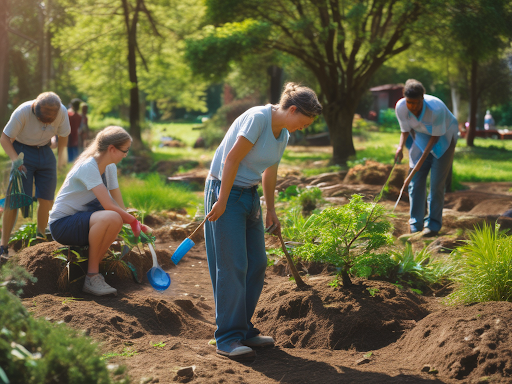Reconnecting with Nature: Workshops for Deep Well-being
Strolling through the narrow streets of a renowned coastal city, I can't help but notice a sense of neglect and abandonment. The image contrasts sharply with the memory of a small inland village where, while working, I had the opportunity to ask the residents how they managed to keep their village so neat and clean. Their answer surprised me: they themselves were regularly responsible for cleaning the streets, mowing the grass, and other maintenance work.
These inhabitants, immersed for most of their time in the greenery, possessed a rare awareness: contact with nature nourishes a deep sense of belonging, stimulating the desire to care for and preserve the surrounding environment.
This profound connection with nature is supported by numerous scientific studies. A study published in the journal Environmental Science & Technology found that spending just 30 minutes in nature can reduce cortisol levels, the stress hormone, and improve mood. Another study, published in Frontiers in Psychology, showed that people who spend more time outdoors tend to have higher self-esteem and feel more connected to their community.
How Nature Helps Us Care for the Environment: The Benefits of a Deep Bond
In addition to giving us a sense of well-being and belonging, contact with nature plays a fundamental role in the care and protection of our planet. Here are some concrete ways in which nature helps us take care of the environment:
1. Regulates the climate and purifies the air:
- Forests act as green lungs: they absorb carbon dioxide and release oxygen, helping to mitigate the greenhouse effect and combat climate change.
- Plants and trees combat air pollution: they absorb pollutants present in the air and release clean air.
- Aquatic ecosystems filter and purify water: rivers, lakes, and wetlands play a fundamental role in purifying water, making it drinkable and supporting the life of numerous species.
2. Protects the soil and prevents erosion:
- Plant roots anchor the soil: preventing it from being washed away by precipitation and wind.
- Vegetation promotes soil fertility: the decomposition of organic matter releases nutrients that enrich the soil and make it more fertile.
- Wetlands act as sponges: they absorb rainwater and reduce the risk of flooding and landslides.
3. Conserves biodiversity:
- Natural ecosystems are home to an enormous variety of living species: plants, animals, fungi, and microorganisms.
- Each species plays an important role in its own ecosystem: their interaction with each other maintains the balance and health of the environment.
- The loss of biodiversity threatens the stability of ecosystems and our very survival.
4. Provides renewable resources:
- Forests provide us with wood, paper, and other natural products.
- Crops provide us with food and fiber.
- Solar, wind, and hydroelectric power are renewable energy sources that do not pollute the environment.
5. Inspires sustainable solutions:
- Observing nature can teach us how to design more sustainable systems.
- Biomimetic architecture is inspired by natural models to create more energy-efficient buildings.
- Organic farming mimics natural processes to produce food without using harmful chemicals.
Taking care of nature means taking care of ourselves. By including contact with nature in our daily lives and supporting environmental conservation initiatives, we can help create a healthier and more sustainable future for all.
What can we do to help nature?
- Spend time outdoors: go for walks, hikes, bike rides, or simply sit in a park.
- Learn about nature: read books, watch documentaries, or take environmental education courses.
- Reduce our environmental impact: recycle, save energy, use less water, and make sustainable consumption choices.
- Support organizations that work for the conservation of nature, not just international ones.
Every little bit counts. Together, we can make a difference and create a better world for future generations.
Understanding the Core Principles of Wild Mindset Coaching
Before diving into specific workshop ideas, it's essential to solidify the core principles of Wild Mindset Coaching:
- Deep connection with nature
- Mindfulness and presence
- Embracing intuition and inner wisdom
- Building resilience and adaptability
- Cultivating a sense of wonder and awe
Potential Wild Mindset Coaching Workshop Ideas
Based on these principles, here are some potential workshop themes:
1. Reconnect with Nature: A Wilderness Immersion
- Focus: Deepening the connection with nature through sensory experiences, mindfulness practices, and outdoor activities.
- Activities: Forest bathing, nature journaling, campfire storytelling, stargazing, and ecological awareness exercises.
2. Unleash Your Inner Wild: Embracing Intuition and Creativity
- Focus: Tapping into intuition, creativity, and personal power through nature-inspired practices.
- Activities: Art therapy, creative writing, vision boarding, shadow work, and intuitive movement.
3. Build Resilience: Finding Strength in Nature
- Focus: Developing resilience, adaptability, and stress management skills using nature as a guide.
- Activities: Obstacle course challenges, survival skills, team-building exercises in nature, and mindfulness practices for overcoming adversity.
4. Mindful Leadership: Leading with Nature's Wisdom
- Focus: Applying nature's principles to leadership, such as collaboration, interdependence, and sustainability.
- Activities: Leadership simulations in nature, group decision-making exercises, and discussions on ethical leadership.
5. Healing and Transformation: Finding Balance in Nature
- Focus: Using nature as a catalyst for personal growth, healing, and transformation.
- Activities: Rituals and ceremonies, sound healing, energy healing practices, and nature-inspired meditation.



Comments
Post a Comment